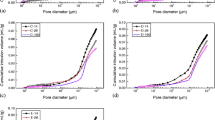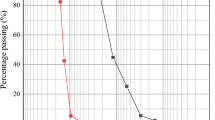Abstract
Experimental research on how reinforcing bars affect the pore structure and compressive strength of concrete was studied in this work. The samples used in the tests were from concrete with 2 mix ratios and 9 reinforcement ratios. At three, seven, and twenty-eight days old, respectively, the concrete compressive strength and the structure of pores were examined. The pore structure of the concrete was discovered to alter as a result of the reinforcing bars. The size of the pore structure of concrete grew larger together with the reinforcement ratio. As the reinforcement ratio rose, the samples of reinforced concrete of the same age lost compressive strength. The formula for calculating the compressive strength of reinforced concrete samples was developed based on the known strength of plain concrete.
Access this chapter
Tax calculation will be finalised at checkout
Purchases are for personal use only
Similar content being viewed by others
References
Li D et al (2018) A predictive model of the effective tensile and compressive strengths of concrete considering porosity and pore size. Constr Build Mater 170:520–526
Bu J, Tian Z (2016) Relationship between pore structure and compressive strength of concrete: experiments and statistical modeling. Sādhanā 41(3):337–344
Lian C, Zhuge Y, Beecham S (2011) The relationship between porosity and strength for porous concrete. Constr Build Mater 25(11):4294–4298
Zhang M et al (2021) Study of concrete strength and pore structure model based on grey relation entropy. Materials 14(2):432
Gao H, Zhang X, Zhang Y (2015) Effect of the entrained air void on strength and interfacial transition zone of air-entrained mortar. J Wuhan Univ Technol-Mater Sci Ed 30(5):1020–1028
Rui Y et al (2022) Comparative study on the effect of steel and polyoxymethylene fibers on the characteristics of ultra-high performance concrete (UHPC). Cement Concr Compos 127:104418
Li Y, Li J (2014) Capillary tension theory for prediction of early autogenous shrinkage of self-consolidating concrete. Constr Build Mater 53:511–516
Zhao H et al (2020) Effects of CaO-based and MgO-based expansion agent, curing temperature and restraint degree on pore structure of early-age mortar. Constr Build Mater 257:119572
Author information
Authors and Affiliations
Corresponding author
Editor information
Editors and Affiliations
Rights and permissions
Copyright information
© 2024 The Author(s), under exclusive license to Springer Nature Singapore Pte Ltd.
About this paper
Cite this paper
Wang, R., Liu, M., Kang, J., Wu, D., Wang, Z., Zhou, X. (2024). Experimental Study of Pore Structure and Compressive Strength of Reinforced Concrete. In: Jeon, HY. (eds) Proceedings of the International Conference on Geosynthetics and Environmental Engineering. ICGEE 2023. Lecture Notes in Civil Engineering, vol 374. Springer, Singapore. https://doi.org/10.1007/978-981-99-4229-9_42
Download citation
DOI: https://doi.org/10.1007/978-981-99-4229-9_42
Published:
Publisher Name: Springer, Singapore
Print ISBN: 978-981-99-4228-2
Online ISBN: 978-981-99-4229-9
eBook Packages: EngineeringEngineering (R0)




